A forgotten battle - The Alps, 10th - 25th June 1940

10th June 1940: Italy entered the war on the side of the Germans. In the Alps, the 190,000 men of General Olry confronted some 450,000 Italians commanded by Prince Umberto of Piedmont. French forces provided support along the "Alps Maginot Line", which consisted of fortifications dating from the end of the 19th century, modernised and completed as a result of a project launched in 1928. In anticipation of an impending conflict with Italy, in alliance with Germany, these fortifications, which were designed to prevent an enemy advance, were extended into the Alps, along the border. The Italians, although superior in number, were poorly trained, badly equipped and not very mobile. In addition, the "Vallo Alpino" (alpine ramparts) constructed by Italy from 1937 onwards in response to the French fortifications, was far from being finished on the outbreak of the war.
At the same time, General Olry was forced to create a new front to protect his rearguard. In fact, the Germans had pushed back the Allies in the North and were descending southwards at high speed. On the 16th June, they had reached Langres and Dijon. They were about to join up with the Italians and "sandwich" the army of the Alps. They had to be stopped! But how?
General Olry coordinated a battle plan in the Rhone valley that relied on the establishment of three successive lines of defence, the first on the Rhone at Lyon, the second along the Isère and the third along the Durance, the implementation of which was entrusted to General Cartier. It was decided not to draw upon troops from the army fighting in the Alps, so as not to weaken it. Units were hastily created using reservists and incorporating soldiers returning from the North, or at least retrieving their equipment to arm other servicemen. Composed of soldiers, some of whom had arrived from Belgium via Dunkirk, England and Brest, marines, airmen, Spahis (Ottoman cavalry corps) and tirailleurs, these troops formed a motley crew. Three coordination and training centres were also established: one in Orange for the cavalry, one in Avignon for the engineers and infantry and one in Nîmes for the artillery.
The first breakthrough came when Lyon was declared an open city. From the 19th June onwards, the army of the Alps had to confront the Germans, who had breached the Rhone over the bridges of Lyon. On the evening of the 20th, General Olry blew up all the bridges across the Isère downriver from Voreppe. The 16th Panzerkorps then attacked along three axes. C company, launched southwards from Vienne, failed along the Isère and the right bank of the Rhone, where the Spahis charged one last time at Andance. On the 23rd, B company, who had set off from Lyon, was stopped in the Voreppe gap, which provided access to Grenoble. A company, coming from Bourg, crossed the Rhone at Culoz, arriving in Aix-les-Bains on the evening of the 23rd June. In spite of everything, the offensive on Chambéry was contained.
On the 22nd and 24th June, France signed armistice agreements with Germany and then with Italy. The ceasefire came into effect from 0035 on the 25th June, but it was not until the beginning of July that the last garrisons of the Maginot line agreed to cease hostilities. Despite its lack of resources against a double front, the army of the Alps managed to successfully defend the border over 400km, by applying its motto "None shall pass". By containing the Italians at the border and slowing down the German advance, they prevented the country from becoming totally occupied.
| 1st September 1939 |
Start of the German attack in Poland. |
|
3rd September 1939 |
Declaration of War on Germany by Great Britain and France |
|
21st March 1940 |
Resignation of Édouard Daladier's government, formation of Paul Reynaud's government |
|
10th May 1940 |
Start of the German offensive in the west: invasion of the Netherlands, Belgium and Luxembourg |
|
13th May 1940 |
German breakthrough at Sedan |
|
15th May 1940 |
Surrender of the Dutch army |
|
18th May 1940 |
Marshal Pétain minister of state and vice-president of the Council |
|
28th May 1940 |
Surrender of the Belgian army |
| 28th May - 4th June | Battle of Dunkirk |
|
5th - 8th June 1940 |
Breach of the last lines of French defence along the Somme and the Aisne |
|
10th June 1940 |
Entry into the war of Italy alongside Germany; evacuation of civilians ahead of and close to French resistance positions; destruction of various access points by the French |
|
12th June 1940 |
First exchanges of fire between French advance ski-borne units and Italians |
|
13th June 1940 |
Bombardment of Turin by the Royal Air Force; bombardment of Toulon and the Fayence and Cannes area by the Regia Aeronautica |
|
14th June 1940 |
Bombardment by the French fleet of the industrial areas of Gênes and Savone; arrival of German troops in Paris, declared an open city. |
| 15th June 1940 | Bombardment by the Regia Aeronautica of the Cuers, le Luc, Hyères and Saint-Raphaël areas |
|
16th June 1940 |
French bombardment of the Novi Ligure area and various targets in Italy; resignation of Paul Reynaud, Marshal Pétain's cabinet is formed |
|
17th June 1940 |
French bombardment of factories in Turin, the aerodrome and railway station in Mondovi and the airfield at Novi Ligure; Italian reconnaissance offensives on the most important points on the border; French request for an armistice |
|
18th June 1940 |
Italian reconnaissance continues; the Germans arrive in Bourg-en-Bresse, Roanne and Mâcon; Lyon declared an open city |
|
19th June 1940 |
Mussolini gives the order to attack; the Germans arrive in Nancy, Vichy and Rennes; the Loire is breached |
|
21st June 1940 |
General Italian offensive in the Alps; occupation of Lyon and Vienne by the Germans |
|
22nd June 1940 |
Signature of the Franco-German armistice at Rethondes |
|
23rd June 1940 |
Occupation of part of Menton by the Italians; the Germans arrive in Aix-les-Bains |
|
24th June 1940 |
Signature of the Franco-Italian armistice in Rome |
| 25th June 1940 | The ceasefire comes into force |
(Lille 28th June 1880 - Angoulême 3rd January 1944) Engineer, René Olry was appointed lieutenant in the 21st artillery regiment on the 10th October 1904. He saw action throughout the First World War, at the headquarters of the 6th Artillery Corps and of the fortified region of Verdun and in the artillery division of the 2nd Army. In 1917, he was a member of the French expeditionary corps in Italy, taking part in the battles of the Piave, before taking command of an artillery division in the 283rd artillery regiment (RA) in 1918. His brilliant conduct earned him five citations during the conflict, including two on the Order of the Army. In 1922, he was secretary of the upper Council at the National Defence and then took part in the French military mission in Greece until 1928. He was then made commanding officer of the 309th Artillery Regiment. He was promoted to Brigade General in 1932 and then Division General in 1935. He then commanded the 29th Alpine Infantry Division, before taking command of the 15th Region in 1937, followed by the 15th Army Corps of the southern Alps in 1939. On the 5th December 1939, he was appointed at the head of the Army of the Alps, with whom he managed, with limited means, to contain the Italian offensive of June 1940 and German pressure on his rearguard.
The front along the Alps was held by alpine troops, mainly composed of fortress troops, whose motto was "None shall pass" and whose surprise elements were the advance ski-borne units (sections d'éclaireurs skieurs or SES). The SES were created in 1931 as a result of the merging of some high mountain instruction centres belonging to each battalion with detachments stationed near the Italian border that had formed a few years earlier. The SES appeared mostly within battalions of alpine chasseurs, alpine infantry regiments, regiments of tirailleurs stationed in the Alps and the alpine fortress battalions created in 1935. Commanded by a lieutenant, these groups were made up of around forty tough men, whose superiors were trained at the Chamonix high mountain military school. The SES were the spearheads of the alpine units. Their missions were long distance reconnaissance, liaising between sectors, protecting strategic positions and slowing down the advance of the enemy. The alpine units had 31 sections of advance ski-borne units in September 1939 and 99 when Italy entered the war on the 10th June 1940.
At the time of Italy's entry into the war, General Houdemon's Airborne Operations Zone of the Alps (la Zone d'opérations aériennes des Alpes or ZOAA), which had the responsibility for withstanding the Italian air force, had reduced means, with two Provisional Squadrons equipped with LeO 451s, three fighter groups and its unique night fighter squadron, an army reconnaissance group and two airborne observation groups, a total of 150 aircraft. However, these groups had the benefit of support from the British who had two squadrons of "Wellingtons" from Bomber Command in Crau, near Salon-de-Provence. Between the 10th and 18th June, the French air force only had one adversary, the Italian air force, which went on the offensive on the 13th and 15th June in attacking the Cannes and Fayence regions, as well as Toulon, followed by the Cuers, le Luc, Hyères and Saint-Raphaël areas. The French air force carried out effective interception missions during which, on the 15th June, Warrant officer Le Gloan of the Fighter Group III/6, brought down five Italian aircraft in less than 40 minutes and, as a result of his exploits, was immediately appointed Sub-lieutenant. Italian aircraft only dared to carry out a few small-scale attacks, with the exception of the one on Marseille on the 21st June. However, from the 18th June onwards, the air force also had to fight on two fronts, alternating reconnaissance missions with bombing the German columns. Because of the bad weather and the overlapping of units on the battlefield, the bombing was somewhat limited. During the fifteen days of the battle, 20 enemy aircraft were officially brought down and many damaged. French losses, not including naval aviation losses, amounted to three officers killed, three pilots injured, two Bloch 152 and MS 406 fighter aircraft and one LeO 451 bomber brought down.
The theatre of operations of the Alps, where French and Italians confronted each other in June 1940, extended from Lake Geneva to the Mediterranean, along a front 400km long and 150 km wide. The Alps was divided into two very distinct zones: one to the north of the Ubaye valley, difficult to cross apart from a few passes that were only negotiable in summer and valleys (the Tarentaise, Maurienne, Briançonnais, Queyras and Ubaye) that had just one crossing point and were consequently well-suited to defence and the other to the south, more penetrable, with the alpine range descending gradually down towards Nice, thus lending itself more favourably to an Italian operation in the Alpes-maritimes département. This front was protected by the southern part of the Maginot line, on which modernisation work was carried out in 1931. To save money, these fortifications did not always run the length of the border, leaving some sectors without protection. With this in mind, they had to make maximum use of the defensive nature of the terrain and concentrate on the Alpes-maritimes and Ubaye sectors. The forts that made up this line of defence were of varying standards: some were modern, well armed and at times manned by strong garrisons, whilst others were lighter, at times only serving as shelters.
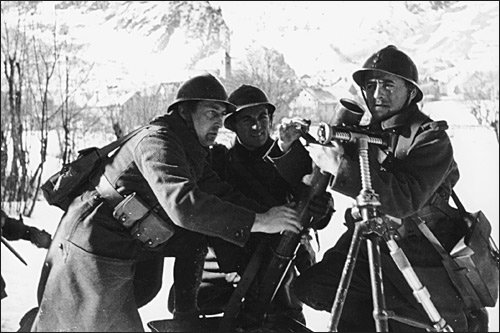
Alpine infantry in Dauphiné setting up an 81 mm mortar. Source: ECPAD France
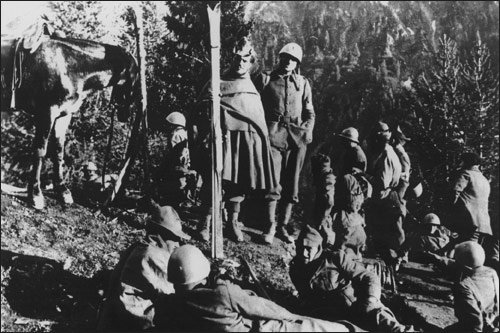
Italian soldiers in the Maurienne at the end of hostilities. Many of them had frozen feet and could not be repatriated.<BR>They were entrusted into French care by their battalions. Source: Museum of the history of mountain troops
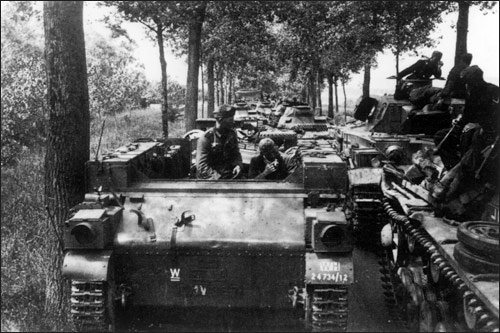
Having crossed the Rhone, the German armies take the army of the Alps from behind.<BR>Source: Museum of the history of mountain troops
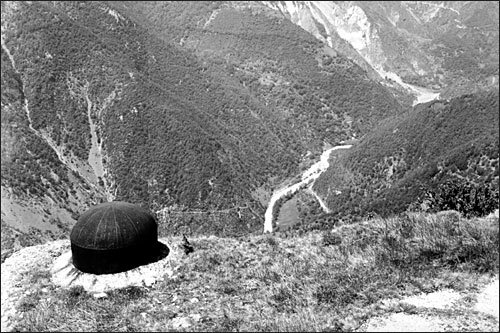
Rimplas, view over the Haute Tinée. Source: ECPAD France
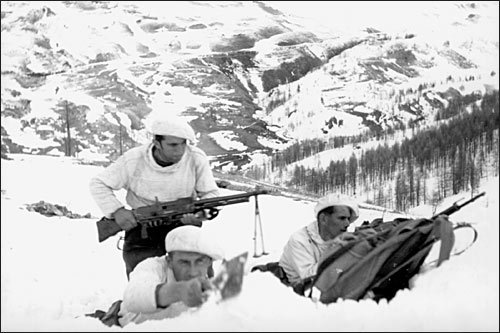
An advance ski-borne unit prepares to line up FM 24-29 machine guns. Source: ECPAD France
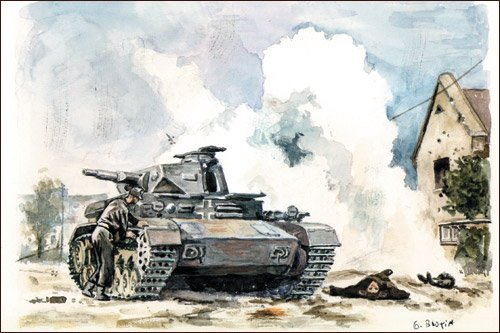
The Battle of Voreppe, by G. Boutin. Source: Museum of the history of mountain troops
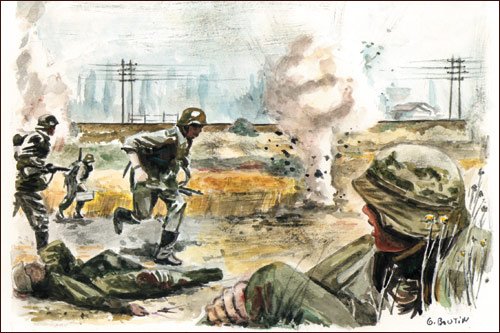
The Battle of Voreppe, by G. Boutin. Source: Museum of the history of mountain troops
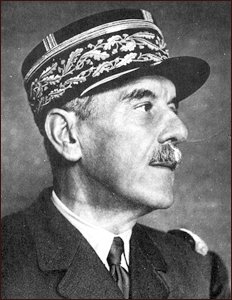
General Olry, commanding the Army of the Alps in 1940. Source: Museum of the history of mountain troops
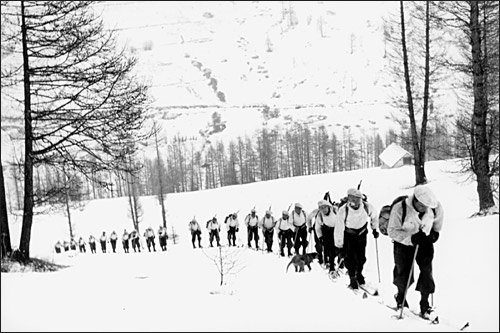
Departure on reconnaissance of an advance ski-borne unit. Source: ECPAD France
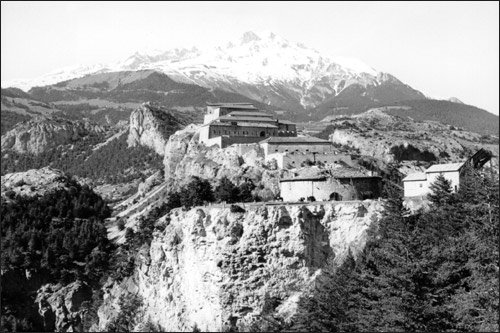
Forts of l'Esseillon. Source: ECPAD France
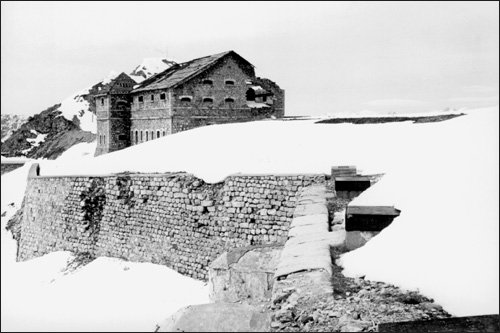
The Janus fort. Source: ECPAD France

